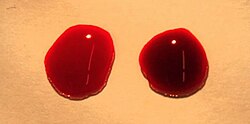Ferro em biologia
Este artigo ou secção necessita de expansão. |
O ferro é um importante elemento biológico.[1][2][3] É usado tanto nas proteínas de ferro-enxofre ubíquas[1] como nos vertebrados, usado na hemoglobina, que é essencial para o transporte de sangue e oxigénio.[4]


Sumário
editarO ferro é necessário para a vida.[1][2][3] As agremiações de ferro-enxofre são generalizadas e incluem a nitrogenase, as enzimas responsáveis pela fixação biológica do nitrogénio. As proteínas que contêm ferro participam no transporte, armazenamento e uso de oxigénio.[1] As proteínas de ferro estão envolvidas na transferência de eletrões.[5] A ubiquidade do ferro na vida originou a teoria do mundo ferro-enxofre, que propõe que as primeiras formas de vida na Terra poderiam ter-se formado na superfície de minerais de sulfureto de ferro.[6][7][8][9][10]
Referências
- ↑ a b c d «Iron». Micronutrient Information Center, Linus Pauling Institute, Oregon State University, Corvallis, Oregon. Abril de 2016. Consultado em 6 de março de 2018
- ↑ a b Dlouhy, Adrienne C.; Outten, Caryn E. (2013). Banci, Lucia, ed. Metallomics and the Cell. Col: Metal Ions in Life Sciences. 12. [S.l.]: Springer. pp. 241–78. ISBN 978-94-007-5560-4. PMC 3924584 . PMID 23595675. doi:10.1007/978-94-007-5561-1_8 electronic-book ISBN 978-94-007-5561-1
- ↑ a b Yee, Gereon M.; Tolman, William B. (2015). «Transition Metal Complexes and the Activation of Dioxygen». In: Peter M.H. Kroneck; Martha E. Sosa Torres. Sustaining Life on Planet Earth: Metalloenzymes Mastering Dioxygen and Other Chewy Gases. Col: Metal Ions in Life Sciences. 15. [S.l.]: Springer. pp. 131–204. ISBN 978-3-319-12414-8. PMID 25707468. doi:10.1007/978-3-319-12415-5_5
- ↑ Maton, Anthea; Jean Hopkins; Charles William McLaughlin; Susan Johnson; Maryanna Quon Warner; David LaHart; Jill D. Wright (1993). Human Biology and Health. Englewood Cliffs, New Jersey, US: Prentice Hall. ISBN 978-0-13-981176-0
- ↑ Greenwood and Earnshaw, pp. 1098–104
- ↑ Wächtershäuser, Günter (1 de dezembro de 1988). «Before enzymes and templates: theory of surface metabolism». Microbiol. Mol. Biol. Rev. 52 (4): 452–84. PMC 373159 . PMID 3070320. doi:10.1128/MMBR.52.4.452-484.1988
- ↑ Wächtershäuser, G (janeiro de 1990). «Evolution of the first metabolic cycles». Proceedings of the National Academy of Sciences of the United States of America. 87 (1): 200–04. Bibcode:1990PNAS...87..200W. PMC 53229 . PMID 2296579. doi:10.1073/pnas.87.1.200
- ↑ Günter Wächtershäuser, G (1992). «Groundworks for an evolutionary biochemistry: The iron-sulphur world». Progress in Biophysics and Molecular Biology. 58 (2): 85–201. PMID 1509092. doi:10.1016/0079-6107(92)90022-X
- ↑ Günter Wächtershäuser, G (2006). «From volcanic origins of chemoautotrophic life to Bacteria, Archaea and Eukarya». Philosophical Transactions of the Royal Society B: Biological Sciences. 361 (1474): 1787–806; discussion 1806–8. PMC 1664677 . PMID 17008219. doi:10.1098/rstb.2006.1904
- ↑ Wächtershäuser, Günter (2007). «On the Chemistry and Evolution of the Pioneer Organism». Chemistry & Biodiversity. 4 (4): 584–602. PMID 17443873. doi:10.1002/cbdv.200790052